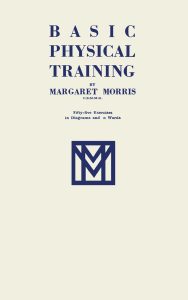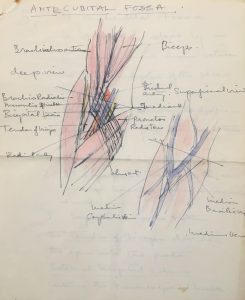This week we dig a little deeper into the story behind a document that was conserved in the course of our project work in 2018, and discover legendary sea creatures and a folk-tale inspired Scottish ballet.
In 2018, project archivist, Clare Button, made a discovery: Margaret Morris’ copy of Erik Chisholm’s musical score for ‘The Forsaken Mermaid’, the first ever full length Scottish ballet. Clare made the remarkable find during her tenacious work to sort and catalogue over 300 boxes of archive material which make up the Margaret Morris Archives. The collection, which covers almost a century of movement, dance and art in Scotland, was donated to the Fergusson Gallery in Perth in 2010. It forms one of three collections included in our ‘Body Language’ project.
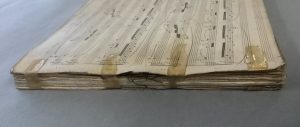
The Forsaken Mermaid manuscript before treatment (Ref: 2010.718)
On discovering the manuscript, which is dated to around 1936, Clare found it in rather poor condition. There were multiple tears to the edges of the paper and evidence of some well-intended but rather non-expert repairs. She carefully packed up the fragile volume and arranged for it to be transported by expert couriers to specialist conservators at the University of Edinburgh’s Centre for Research Collections.
On arrival at the University of Edinburgh’s main library, the volume was unpacked by the conservation team in the bright, clinically clean, fifth-floor conservation studio. Amidst a hive of conservation activity (from re-binding rare seventeenth-century books to repairing early twentieth-century glass plate negatives), this curious manuscript met with experienced book and paper conservation student, Lisa Behrens.
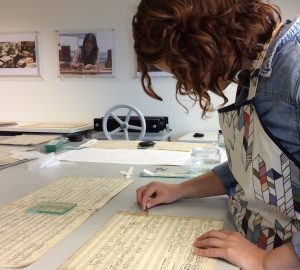
Book and paper conservation student, Lisa Behrens, carefully removing adhesive tape from the Forsaken Mermaid mansucript
Lisa’s first task was to dry-clean the volume and then, over two days, she painstakingly removed multiple layers of adhesive tape and binding threads. Each of the individual sheets were repaired using Japanese paper, pressed overnight and then re-sewn using a French sewing technique. This ensured that the conservation treatment did not damage the volume further and helps to protect it from further damage while still allowing it to be accessible to researchers.
A University of Edinburgh alumni (1931 and 1934), Erik Chisholm (1904-1965) was a leading Scottish modernist composer. Glasgow born Chisholm jointly founded the Celtic Ballet with Margaret Morris. At the age of 34, he was appointed Celtic Ballet’s director of music in 1938, although he had composed the musical score for ‘The Forsaken Mermaid’ earlier, in 1936. The choreography for ‘The Forsaken Mermaid’ was by Morris and the set and costumes by the artist, and then principal of Glasgow School of Art, Andrew Taylor-Elder (1908-1966). Celtic Ballet performed ‘The Forsaken Mermaid’, their inaugural production, at the Lyric Theatre, Glasgow, on 6 December 1940.
A curious folk-tale, ‘The Forsaken Mermaid’ features those legendary supernatural sea people, human from the head to the waist but with a fish tail instead of legs. There are many folk-tales of love stories and marriages between a mermaid and a man, some have even claimed descent from such a union. This particular story takes place under and on the water and partly on land. ‘The Forsaken Mermaid’ tells the story of a mermaid who fell in love with a man when she is caught in a fisherman’s net. But the man grows tired of her and she returns to the sea in despair. The sea-people seek revenge in a terrible storm, drowning the fishermen. The mermaid pleads for the life of her love.
Subsequent Celtic Ballet productions were set to Scottish themes and incorporated elements of Margaret Morris Movement, Scottish country and Highland dance styles. Celtic Ballet went on to tour in Europe, Russia and the United States of America. They were one of the first British companies to perform in France after the second world war. Chisholm went on to be appointed the Principal of the College of Music at the University of Capetown where he remained until his death in 1965. He held a lifelong interest in Scottish music and published a collection of Celtic folk-songs in 1964.
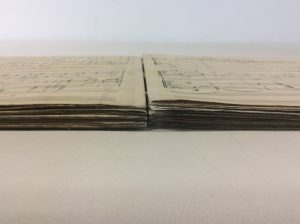
The Forsaken Mermaid manuscript after treatment (Ref: 2010.718)
This annotated manuscript is evidence of just one of multiple collaborations with artists that Margaret Morris spearheaded, which can be found throughout the collection. Since undergoing successful conservation treatment, it has now been returned to its home at the Fergusson Gallery at Perth. While the gallery remains closed for the time-being (July 2020) in line with Scottish Government guidance on coronavirus restrictions, there are lots of sources online where you can find out more.
- You can read more about the conservation treatment of the volume on Centre for Research Collections conservation blog ‘To Protect and (Con)serve’.
- We love this fantastic video footage from 1923 showing Margaret Morris Merry Mermaids, showing dancers at Harlech beach performing mermaid inspired movement, courtesy of the British Film Institute.
- Artist Donald Bain’s painting ‘Celtic Ballet: Forsaken Mermaid’ can be viewed on the National Galleries Scotland website.
- The Celtic Ballet and its history feature in this opinion piece from ‘The National’ newspaper.
- There is some fascinating reading around Erik Chisholm and his career to be found on the Erik Chisholm Trust website.

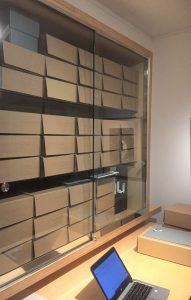
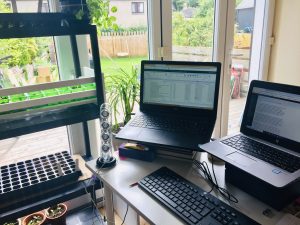
 In 2018, a
In 2018, a  In 2020, we can now add the stresses and strains of coronavirus (COVID-19) into the mental health mix. There is little doubt that current measures around social distancing and restrictions on movement – in place to protect ourselves and others from coronavirus – are exacerbating the collective strain on mental and physical well-being. Mental health organisation websites (such as the
In 2020, we can now add the stresses and strains of coronavirus (COVID-19) into the mental health mix. There is little doubt that current measures around social distancing and restrictions on movement – in place to protect ourselves and others from coronavirus – are exacerbating the collective strain on mental and physical well-being. Mental health organisation websites (such as the 